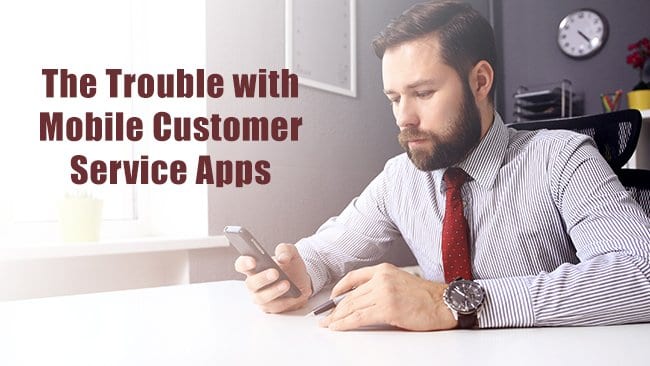
The theory behind mobile customer service apps may be sound, but in practice, the challenges to adoption are significant.
Modern contact centers are expected to support a wide range of multimedia communication, due to the growing demand for digital channels. Given the present ubiquity of smartphones, it is no surprise then that many enterprises are seeking to develop a mobile customer service application as part of this drive towards multiple channels.
Customer Service Apps
However, there are a multitude of complexities associated with the provision and uptake of a mobile app within the confines of the contact center experience. For one thing, voice clearly remains the most popular channel for customers, and weaning people off of the familiar is never an easy task, despite the obvious benefits this may offer to both the organization and the customer.
For the enterprise, voice remains the most costly channel, while users who fail to utilize an option like a mobile app are making their own lives more difficult, as a channel like this should have been designed to improve the simplicity of making contact with the business.
Mobile App and Digital Channels
After all, digital channels like mobile apps are supposed to increase the customer’s satisfaction – not only does it offer them a self-service capability, but it means they will no longer have to sit on hold on the phone, waiting for help – and increased satisfaction means they remain happy with your business.
However, despite the clear benefits a channel such as this offers, many companies find that even though they have invested heavily in developing a mobile app, with a view to enabling customers to perform routine transactions in a simplified manner, precious few of their clientele have bothered to download it. Worse still, only a few of those who download it actually bother to use it.
The reasons for this are myriad and complex, and are often as much due to internal issues as they are to customers’ unwillingness to try something new. For example, a lack of internal collaboration may occur between the various players involved in the app’s implementation, meaning that the integration of features within these mobile apps is often quite rudimentary.
In addition, some businesses make the mistake of looking at their mobile app development as a once-off project. The assumption is that once the app is complete, all is good with the world, when the truth is that it is only once the app goes live that the real development begins. Bugs need to fixed, new features need to be built at the users’ request and the developers need to keep the app current with any and all platform changes.
Errors or bugs in the finished product are one of the biggest challenges companies face when driving and maintaining uptake of the service. Customers are quick to leave negative reviews should there be any issues with the app and many will immediately abandon it. In fact, according to a 2016 survey from Sitecore and Vanson Bourne¹, around one third of those polled claimed that they would give up on a brand completely after just one poor mobile experience.
Therefore, solving any errors or bugs should receive the highest priority, but this is seldom what happens in the real world. Another problem with such apps is that the developers fail to ask the critical question: ‘what needs does this app meet?’ If it fails to meet the demands of the customer, it doesn’t matter how well it works or how effectively it was designed, uptake is likely to be minimal. Furthermore, the in-app experience needs to connect with and match up to the web experience that a customer may already be used to. Failure to do so will almost certainly turn the customer off.
Self Service Channel for better Customer Experience
Some enterprises have sought to deliver an improved customer experience by building in easy-to-use live help access, including the ability for an agent to co-browse with the relevant customer. While this enables an agent to actually assist the customer with learning how to use the app properly, it also defeats the main purpose of providing a self-help channel – which is to save costs by eliminating the need for an agent to be involved in the transaction.
Another issue that can affect the mobile customer service app is a failure to build it in such a way that it operates correctly across the multitude of mobile devices, which have different manufacturers, screen sizes and operating systems. Unless this is properly taken into account, it may have a negative impact on how the app functions. Failure to provide a consistent user experience across phones, tablets and other devices is likely to end up with an increasing number of customers avoiding using the app.
In addition, security is a growing concern amongst users of electronic devices, with many consumers refusing to download a mobile app they don’t trust. An altogether larger number will also have concerns about leaving themselves vulnerable to outside threats, leading to another reason for lack of uptake.
Then there is the simple matter that a large number of customers will fall into one of the age groups that are less than comfortable using the latest technology solutions. These are people that have spent many years accepting the fact that the phone is the go-to device for contacting a company, and because they are less tech-savvy, will have a built-in suspicion towards new technology offerings.
Improve Customer Experience with Mobile Support
Moreover, those that are more comfortable with new solutions will expect their mobile phone experience to match their expectations, which are likely to be quite high. If these expectations are not met, they will consider it to be a poor substitute, and will go straight to the phone instead. And they will probably not bother to use the app a second time.
Ease of use is another critical factor – people naturally shy away from apps that are unintuitive and hard to comprehend initially. So unless the app is simply designed – though not too simply, otherwise it will not be able to provide the service required –offers convenience and ease of access, they may also be put off the technology.
Educating customers around the use of the mobile app is one way to drive increased uptake, but once again, this costs money and needs to be targeted properly, and at the right customer segments, so it is often a low priority from the enterprise’s perspective.
Finally, there is the irritation caused by the need to download the app in the first place. This is an extra barrier for an irritated customer. After all, if they are experiencing a customer service problem, they are unlikely to go to the trouble of downloading it in order to make contact. Neither are they likely to download it at any other time, since it simply not something they are going to think about until it is needed – by which time it is too late and they are probably going to find making a phone call to be the simpler route.
So, while the theory behind a mobile app for customer service is a good one, the practice often leaves a lot to be desired, and based on the above, it is not difficult to understand why the majority of customers still avoid this contact channel. Mobile apps may yet become a meaningful channel for the contact center, but until the many challenges outlined above can be solved by the enterprise, the signs suggest that it will remain a niche and peripheral channel at best.
[About the author]


